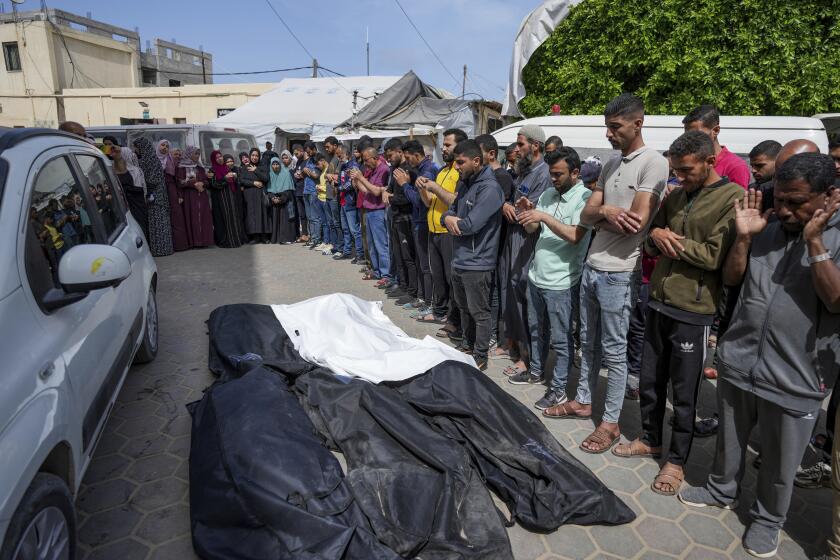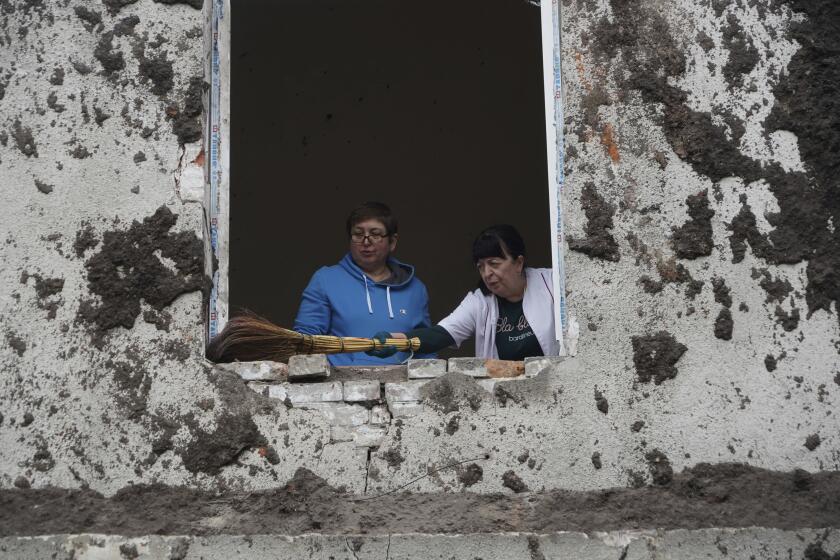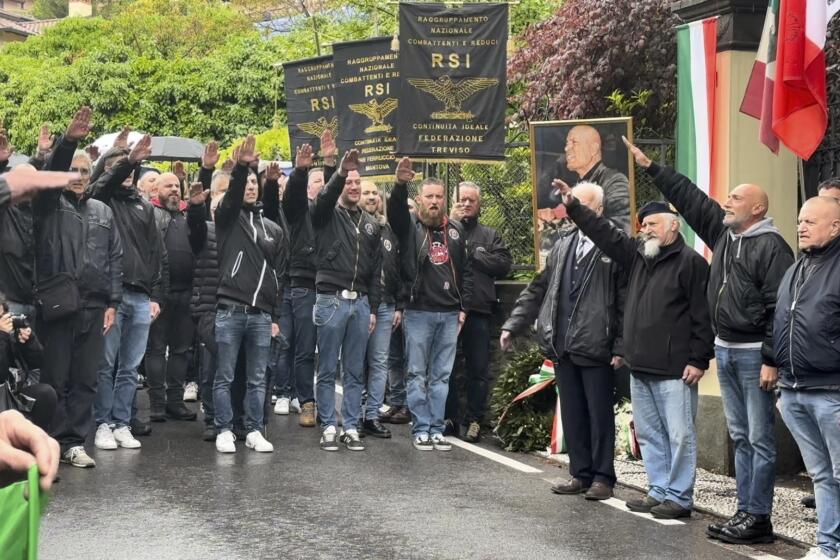Top Aquino Aide Slain in Ambush : Philippine Cabinet Member Supported Vigilante Squads
Five assassins ambushed and killed one of President Corazon Aquino’s most influential Cabinet members as he rode home from church Sunday evening. The official’s driver also died in the ambush, which resembled a recent spate of execution-killings by urban guerrillas of the Communist New People’s Army.
After praying beside the body of Secretary of Local Government Jaime Ferrer in a morgue here Sunday night, Aquino issued a statement condemning the slaying as “senseless and barbaric” and saying that she was shocked “beyond words” by the murder.
It was the first assassination of a Cabinet-rank official in Philippine history, and Aquino ordered all flags to be flown at half-staff “for several days.”
Communists Suspected
Several presidential aides speculated after the killing that Ferrer, 70, a vocal anti-Communist who has been spearheading the government’s creation of a nationwide citizens’ counterinsurgency army, was killed by members of urban-based Communist hit squads that call themselves Sparrow Units.
Gen. Fidel V. Ramos, the armed forces chief of staff who has been trying to restore the credibility of the nation’s military, refused to blame Communist rebels for the killing.
Briefing reporters outside the hospital morgue where he, Aquino and several Cabinet ministers knelt in prayer Sunday night, Ramos said: “We are not making any conclusions at this time, but there are already certain patterns emerging which would . . . lead to the most probable perpetrators of this crime.”
Ramos vowed: “We will leave no stone unturned” in solving “this very despicable crime.”
Shot Eight Times
Police investigators said that Ferrer, who routinely returned home from St. Andrew’s Parish Church at the same hour on Sunday evenings, was shot eight times in the head, neck and shoulders as he rode in the back seat of his car, approaching his modest home on a small side street in the Manila district of Paranaque just after 6:30 p.m.
According to eyewitnesses, the five gunmen had been eating at a hamburger stand across the street. When Ferrer’s car came into view, the five jumped from their seats, ran to the secretary’s car, surrounded it and began shooting. Three gunmen fired at Ferrer and one shot at his driver, Zosimo Calderon.
Police later said that the firearms used included at least one .45-caliber pistol and an Uzi submachine gun.
Unlike most Philippine government officials, Ferrer never carried a firearm or traveled with bodyguards. During an interview with The Times earlier this year, Ferrer said he was trying to persuade the regional governors and mayors who served under him to also travel unarmed.
“There is a lot of killing going on, and I don’t think it is necessary,” Ferrer said. “Arming ourselves like this is not the right approach.”
Car Pursued
Gen. Ramos said that patrolmen in a police station 250 yards from the ambush site heard the shooting and chased the apparent getaway car, firing several shots.
That car, stained with blood, was later found at Manila’s domestic airport, and investigators were monitoring a flight that took off for the central Philippine city of Cebu soon after the killing to determine if the assassins were on board.
Ramos added that soldiers, manning more than 40 military checkpoints that have been in place around Manila since a wave of urban terrorism began several months ago, also were stopping every vehicle and searching for the assailants.
The only other theory police offered for the killing of the popular and highly principled political leader was the possibility of political revenge for Ferrer’s firing of appointed mayors, governors and other local officials in his capacity as local government secretary. Ferrer, who was widely respected for his personal honesty, dismissed scores of such officials for offenses ranging from corruption to murder.
Aquino had dismissed all of the nation’s 73 elected governors and more than 1,000 mayors after she took power 18 months ago in the wake of a civilian-backed military uprising that drove former President Ferdinand E. Marcos from office.
However, military officials who have investigated several other recent assassinations of police, armed forces and local government authorities said the slaying of Ferrer fit an emerging pattern of New People’s Army urban guerrilla assaults in the capital.
On Friday, Gen. Alexander Aguirre, military commander for metropolitan Manila, said that at least 100 Communist hit men are now in the city and that they have been behind the recent killings of police and local officials. Aguirre added that Rudolfo Salas, a guerrilla chieftain captured last year by police, told questioners that the number of rebel hit men in Manila is more than 300.
Military intelligence sources identified the most active of the hit squads as the Alex Boncayao Brigade, which the most recent issue of the Philippine Communist Party’s magazine, Liberation, called “a welcome presence to the city’s poor.”
The assassination squads, the party said, were formed to protect the city’s millions of urban poor from abuses and corruption by Manila’s policemen. The magazine added that the so-called Sparrow Units, whom they refer to as “armed city partisans,” have now built permanent bases in the city’s vast squatters areas.
“Being an extension of the armed struggle in the countryside, partisan warfare also seeks to tie down enemy troops in Manila, weaken their capacity to attack the New People’s Army in the countryside and wreck the fighting morale of the Armed Forces of the Philippines,” the party said.
During the six months that Ferrer served as local government secretary, the veteran political leader was best known publicly for his commitment to citizens’ vigilante squads, which have been formed nationwide, largely under the auspices of local military commanders.
Although Ferrer recommended that the “citizens’ army” be unarmed and act merely as intelligence agents for the military in the thousands of Philippine villages now influenced by the rebels, his fervent anti-Communist stand was often cited by the Philippine media.
Ferrer, who had served as an opposition national assemblyman for two years before the overthrow of Marcos last year, was a vocal Marcos foe and was considered among Aquino’s closest Cabinet collaborators.
In her statement Sunday night, Aquino described Ferrer as “a kind, gentle and honest man.”
The nation’s newly elected legislators reacted to the killing with anger and frustration today.
Sen. Aquilino Pimental, who was replaced by Ferrer as local government secretary earlier this year, said that the assassination “focuses on the sad state of affairs of peace and order in this country.”
Aquino’s cousin, Congressman Francisco Sumulong, said: “Let us not just grieve and condemn the killing. Let us do something about it, and let’s do it as soon as possible.”
The only element of controversy in Ferrer’s public-service career, which began during World War II when he served as a guerrilla fighter against Japanese occupation forces in Manila, came during the 1950s, when Ferrer was accused of working for the American CIA.
With the help of a known CIA officer, Ferrer created this country’s first citizens’ poll-watcher group, called the National Citizens Movement for Free Elections. The group was revived for the 1984 National Assembly elections and for the tainted presidential election last year that marked the beginning of Marcos’ downfall.
Ferrer said in an interview, however, that he did not know that the American who helped him form the poll-watcher group was working for the CIA at the time.
Bombarded with criticism from the Philippine media that formation of the citizens’ army this year was also a CIA-sponsored project, Ferrer told The Times: “This is all my idea. I’ve not contacted anybody on this.
“I just think this is the only way to bring peace.”
More to Read
Start your day right
Sign up for Essential California for news, features and recommendations from the L.A. Times and beyond in your inbox six days a week.
You may occasionally receive promotional content from the Los Angeles Times.






